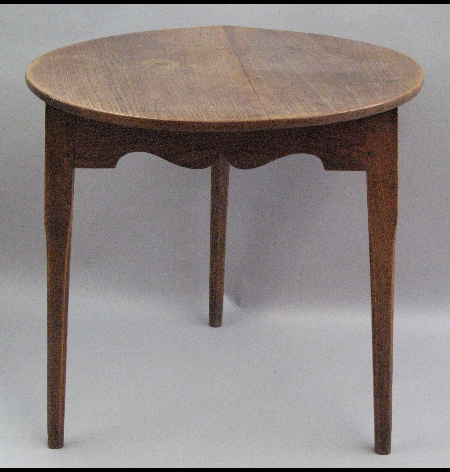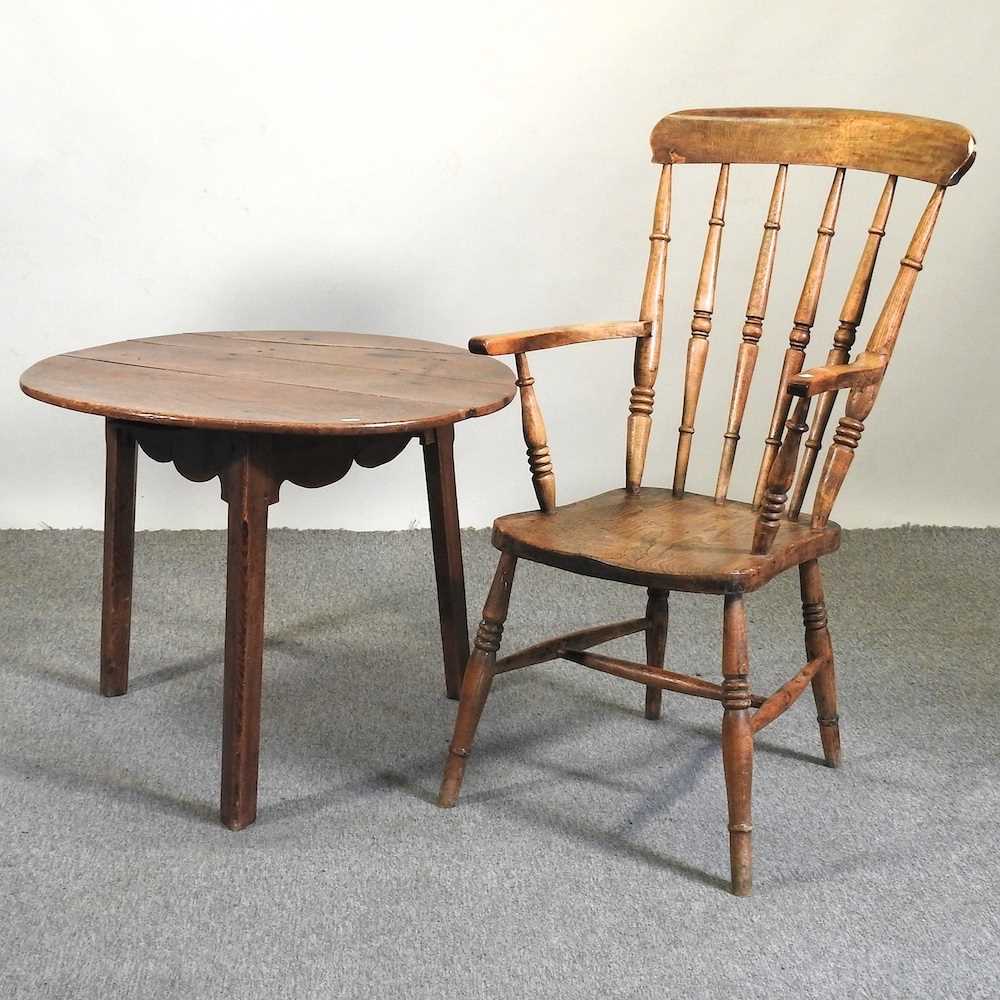AN 18TH-CENTURY CRICKET BAT (pre-1787), of light wood, possibly willow, with right-handed curve and distinctive hook-shape to base, no shoulders, made by William Pett of Sevenoaks with two impressed marks, "W. Pett 7. Oaks" on top of handle and "Will m . Pett Sevenoaks Kent" on base, overall length 40½in., width at centre of blade 4¼in., max. width of base just under 2¾in., weight 2lb. The curved shape of this bat and the type of maker's mark are consistent with it being made in the mid-18th century. Despite a large chip to one edge, several chips and dents to the face, another chip to the top of the handle and scattered worm-holes to the blade, it is in remarkably fine condition with the twine grip still preserved on the long handle. It makes an interesting comparison with the 18th-century oak bat made by Thomas Edmonds formerly in the MCC collection and included as lot 665 in Christie's MCC Bicentenary Auction of 1987. This was more than double the weight at 5lb. 5oz. However, it had the maker's name stamped on the base in similar fashion; and apart from having a left-handed rather than a right-handed curve, was essentially the same shape, exactly the same length and with the same form of surviving twine grip. Immense weight is not a necessary characteristic of surviving 18th-century bats. The oldest known bat, inscribed "J. C. 1729" and kept at the Oval, weighs only 2lb. 4oz. (see Wisden Book of Cricket Memorabilia p. 229). Hugh Barty-King in Quilt Winders and Pod Shavers (1979, p. 46) refers to another surviving bat made by Pett himself weighing 2 lb. 2oz. William Pett is one of the few recorded makers of bats prior to the 19th century. As G. D. Martineau observes in Bat, Ball, Wicket and All (London, 1950, pp. 19-20) "comparatively little is known of bat-makers in the 18th century; for bat-making then was usually only a small part of the trade of a turner, patten-maker or basket-maker". Martineau records the names of two London bat makers, Christopher Thorn and George Wheeler. Then adds: "The names of the other bat-makers of the 18th century which we know are Wm. Pett and his son Thomas both of Sevenoaks, John Small, senior, of Petersfield, William Staples of Sevenoaks, and Charles Budd of Brighton...." There is much more detailed discussion of Pett, who died in 1786, in Barty-King's Quilt Winders and Pod Shavers , pp. 44-47. It is noted therein that "By the 1770's William Pett must have been making cricket bats on a reasonably large scale, for they seem to have been readily available for purchase in retail shops in London and probably elsewhere". Evidence for their popularity comes from Fanny Burney's diary where she quotes a letter from a friend in the west country, Mrs Rishton, asking her '"to buy Mr. Rishton two cricket bats made by Pett of 7 Oaks. You will get them at any of the great toy shope, the maker's name always stamp'd upon them."' Here the weight of bat asked for is heavier. '"Let them weigh 4lb and a quarter or 4lb and a half each. Send them by the Exeter post coach,"' says Mrs Rishton in her letter. Provenance : This bat, and that in the next lot, have been removed from Hollin Hall, Nr. Ripon, North Yorkshire, following the death of the last direct descendant of the Boynton Wood family. The bats, together with other artefacts dating from the 18th century, were found earlier this year behind a very large George III mahogany breakfront bookcase; as opposed to being deliberately put there, they must have fallen down from the top of the bookcase which was installed during refurbishments to the house in the later part of the century; the side panels to the bookcase meant there was no way of recovering the bats unless the enormously-heavy bookcase was itself moved. The bats may have belonged either to John Wood of Copmanthorpe and Hollin Hall (d. 15 Nov. 1778) who assumed the name of Boynton, and is the person who commissioned the bookcase while aggrandising the family mansion; or to his younger brother Rich
AN 18TH-CENTURY CRICKET BAT (pre-1787), of light wood, possibly willow, with right-handed curve and distinctive hook-shape to base, no shoulders, made by William Pett of Sevenoaks with two impressed marks, "W. Pett 7. Oaks" on top of handle and "Will m . Pett Sevenoaks Kent" on base, overall length 40½in., width at centre of blade 4¼in., max. width of base just under 2¾in., weight 2lb. The curved shape of this bat and the type of maker's mark are consistent with it being made in the mid-18th century. Despite a large chip to one edge, several chips and dents to the face, another chip to the top of the handle and scattered worm-holes to the blade, it is in remarkably fine condition with the twine grip still preserved on the long handle. It makes an interesting comparison with the 18th-century oak bat made by Thomas Edmonds formerly in the MCC collection and included as lot 665 in Christie's MCC Bicentenary Auction of 1987. This was more than double the weight at 5lb. 5oz. However, it had the maker's name stamped on the base in similar fashion; and apart from having a left-handed rather than a right-handed curve, was essentially the same shape, exactly the same length and with the same form of surviving twine grip. Immense weight is not a necessary characteristic of surviving 18th-century bats. The oldest known bat, inscribed "J. C. 1729" and kept at the Oval, weighs only 2lb. 4oz. (see Wisden Book of Cricket Memorabilia p. 229). Hugh Barty-King in Quilt Winders and Pod Shavers (1979, p. 46) refers to another surviving bat made by Pett himself weighing 2 lb. 2oz. William Pett is one of the few recorded makers of bats prior to the 19th century. As G. D. Martineau observes in Bat, Ball, Wicket and All (London, 1950, pp. 19-20) "comparatively little is known of bat-makers in the 18th century; for bat-making then was usually only a small part of the trade of a turner, patten-maker or basket-maker". Martineau records the names of two London bat makers, Christopher Thorn and George Wheeler. Then adds: "The names of the other bat-makers of the 18th century which we know are Wm. Pett and his son Thomas both of Sevenoaks, John Small, senior, of Petersfield, William Staples of Sevenoaks, and Charles Budd of Brighton...." There is much more detailed discussion of Pett, who died in 1786, in Barty-King's Quilt Winders and Pod Shavers , pp. 44-47. It is noted therein that "By the 1770's William Pett must have been making cricket bats on a reasonably large scale, for they seem to have been readily available for purchase in retail shops in London and probably elsewhere". Evidence for their popularity comes from Fanny Burney's diary where she quotes a letter from a friend in the west country, Mrs Rishton, asking her '"to buy Mr. Rishton two cricket bats made by Pett of 7 Oaks. You will get them at any of the great toy shope, the maker's name always stamp'd upon them."' Here the weight of bat asked for is heavier. '"Let them weigh 4lb and a quarter or 4lb and a half each. Send them by the Exeter post coach,"' says Mrs Rishton in her letter. Provenance : This bat, and that in the next lot, have been removed from Hollin Hall, Nr. Ripon, North Yorkshire, following the death of the last direct descendant of the Boynton Wood family. The bats, together with other artefacts dating from the 18th century, were found earlier this year behind a very large George III mahogany breakfront bookcase; as opposed to being deliberately put there, they must have fallen down from the top of the bookcase which was installed during refurbishments to the house in the later part of the century; the side panels to the bookcase meant there was no way of recovering the bats unless the enormously-heavy bookcase was itself moved. The bats may have belonged either to John Wood of Copmanthorpe and Hollin Hall (d. 15 Nov. 1778) who assumed the name of Boynton, and is the person who commissioned the bookcase while aggrandising the family mansion; or to his younger brother Rich















Try LotSearch and its premium features for 7 days - without any costs!
Be notified automatically about new items in upcoming auctions.
Create an alert